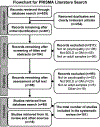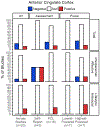Psychopathy and medial frontal cortex: A systematic review reveals predominantly null relationships
- PMID: 39343080
- PMCID: PMC12208374
- DOI: 10.1016/j.neubiorev.2024.105904
Psychopathy and medial frontal cortex: A systematic review reveals predominantly null relationships
Abstract
Theories have posited that psychopathy is caused by dysfunction in the medial frontal cortex, including ventromedial prefrontal cortex (vmPFC), anterior cingulate cortex (ACC), and dorsomedial prefrontal cortex (dmPFC). Recent reviews have questioned the reproducibility of neuroimaging findings within this field. We conducted a systematic review to describe the consistency of magnetic resonance imaging (MRI) findings according to anatomical subregion (vmPFC, ACC, dmPFC), experimental task, psychopathy assessment, study power, and peak coordinates of significant effects. Searches of PsycInfo and MEDLINE databases produced 77 functional and 24 structural MRI studies that analyzed the medial frontal cortex in relation to psychopathy in adult samples. Findings were predominantly null (85.4 % of 1573 tests across the three medial frontal regions). Studies with higher power observed null effects at marginally lower rates. Finally, peak coordinates of significant effects were widely dispersed. The evidence failed to support theories positing the medial frontal cortex as a consistent neural correlate of psychopathy. Theory and methods in the field should be revised to account for predominantly null neuroimaging findings.
Keywords: Anterior cingulate cortex; MRI; Neuroimaging; Prefrontal cortex; Psychopathy.
Copyright © 2024 The Authors. Published by Elsevier Ltd.. All rights reserved.
Conflict of interest statement
Declaration of Competing Interest None.
Figures











Similar articles
-
Effective connectivity of default mode network subsystems and automatic smoking behaviour among males.J Psychiatry Neurosci. 2024 Dec 17;49(6):E429-E439. doi: 10.1503/jpn.240058. Print 2024 Nov-Dec. J Psychiatry Neurosci. 2024. PMID: 39689937 Free PMC article.
-
How reliable are amygdala findings in psychopathy? A systematic review of MRI studies.Neurosci Biobehav Rev. 2022 Nov;142:104875. doi: 10.1016/j.neubiorev.2022.104875. Epub 2022 Sep 15. Neurosci Biobehav Rev. 2022. PMID: 36116578
-
Neural correlates of dysfunctional emotion regulation in major depressive disorder. A systematic review of neuroimaging studies.Neurosci Biobehav Rev. 2013 Dec;37(10 Pt 2):2529-53. doi: 10.1016/j.neubiorev.2013.07.018. Epub 2013 Aug 6. Neurosci Biobehav Rev. 2013. PMID: 23928089
-
Imaging modalities for the non-invasive diagnosis of endometriosis.Cochrane Database Syst Rev. 2016 Feb 26;2(2):CD009591. doi: 10.1002/14651858.CD009591.pub2. Cochrane Database Syst Rev. 2016. PMID: 26919512 Free PMC article.
-
The cognitive and neural correlates of psychopathy and especially callous-unemotional traits in youths: a systematic review of the evidence.Dev Psychopathol. 2014 Feb;26(1):245-73. doi: 10.1017/S0954579413000527. Epub 2013 Sep 30. Dev Psychopathol. 2014. PMID: 24073742
References
-
- Anderson NE, Steele VR, Maurer JM, Rao V, Koenigs MR, Decety J, Kosson DS, Calhoun VD, Kiehl KA, 2017. Differentiating emotional processing and attention in psychopathy with functional neuroimaging. Cognitive Affective & Behavioral Neuroscience 17, 491–515. 10.3758/s13415-016-0493-5 - DOI - PMC - PubMed
Publication types
MeSH terms
Grants and funding
LinkOut - more resources
Full Text Sources
Medical

